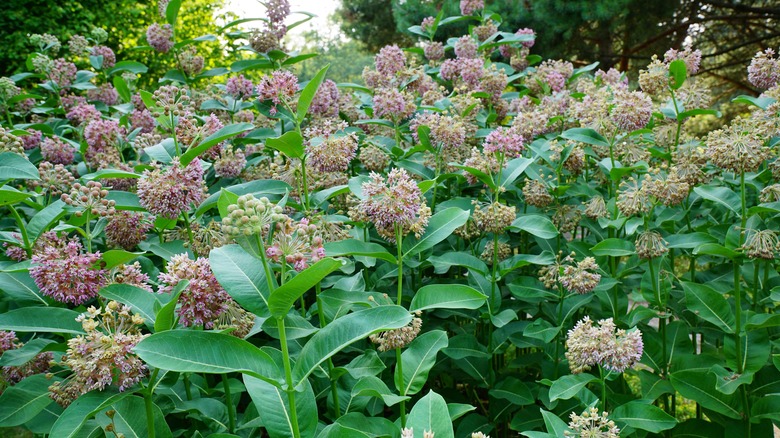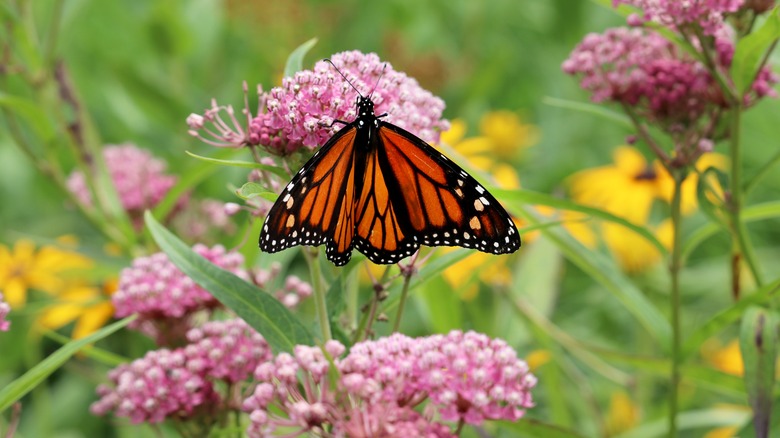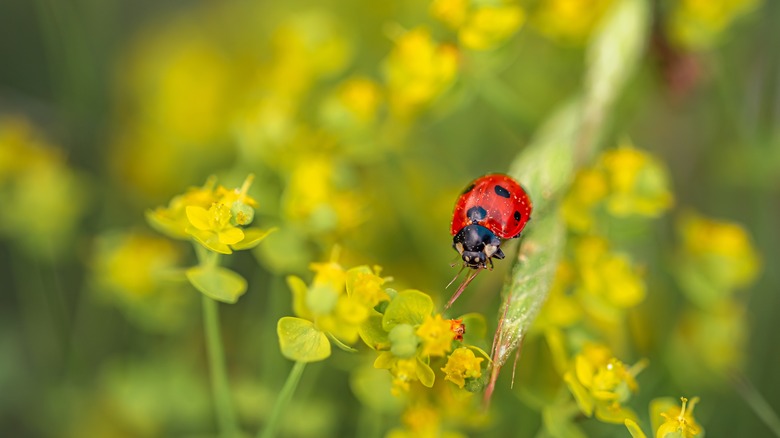The Biggest Mistake Gardeners Make When Tending To Their Milkweed
Milkweed is a beautiful addition to any backyard, but gardeners usually choose to include it in their landscape not for its aesthetic but to attract pollinators and butterflies. It not only attracts bumble bees, but it's the only plant that Monarch butterflies choose to lay their eggs on. That means your yard will be a-buzz with exciting activity all season long. It's also a great native plant to add to your design if you're concerned with conservation and creating an eco-friendly backyard. However, just like with any growing plant in your garden, milkweed is susceptible to pests, mainly aphids. But you mustn't make the mistake of using pesticides to remedy the problem, mainly because it can harm or even kill the pollinators that are attracted to the plant.
Using any sort of pesticide — even an eco-friendly one like rubbing alcohol — can kill off the Monarch caterpillars living on them or harm the bumble bees or Monarchs that visit them. This will not only throw off your local ecosystem, but it defeats the purpose of planting milkweed in the first place. Here is why using pesticides is a mistake you should avoid at all costs.
Why you shouldn't use any kind of pesticide on milkweed
While scientists aren't 100% sure why Monarch populations are dwindling, it is strongly suspected that one of the main reasons is due to pesticides. The population has plummeted by 90% in the last 20 years, making the issue very pressing. These harmful sprays and soaps kill off the caterpillars and poison the butterflies, endangering them. Additionally, some studies suggest that Monarch butterflies tend to ignore milkweed plants coated in things like pesticides, fungicides, and herbicides when it comes to laying their eggs. For example, one 2020 study in the Journal of Applied Ecology found that 30% fewer eggs were found on treated milkweed, indicating a disfavor. If there isn't uncontaminated milkweed nearby, they will fly long distances to find a replacement. If they can't find one, they might lay their eggs on a different plant, though it is extremely rare. If that does happen, the resulting caterpillar will die soon after since milkweed is its preferred diet, and it won't eat anything else.
However, it is still unclear whether all Monarch butterflies intentionally avoid laced milkweed plants, or if it's coincidental that many of them seem to. More research is still necessary. But one thing we do know for sure is that if they don't — and a butterfly drinks pesticide-laced nectar or a caterpillar eats a herbicide-coated milkweed leaf — it can lead to potential harm or death.
How to treat your milkweed instead
To stay on the safe side and protect the Monarch and pollinator population, it's best to avoid any sort of pesticide, herbicide, or fungicide when treating your milkweed. Instead, try to use all-natural methods to deter and remove pests such as aphids from your plants. One great way to do so is to introduce the pest's natural predator into your garden's ecosystem. This includes ladybugs and green lacewings. Ladybugs can consume up to 50 aphids in 24 hours, whereas lacewings can devour up to 1,000! This will quickly take care of your pest problem while leaving the visiting pollinators safe from any potential harm.
If you can't do that, then your best bet is to control the aphid population so it doesn't become an infestation. Having a few aphids on your plants isn't any cause for concern; it's only when you get a robust colony that the plant may suffer. Using things such as pesticides, dish soap, rubbing alcohol, or other treatments can all negatively impact pollinators that either live on or visit the plant. Instead, it's best to either routinely pick off and squish the aphids by hand, use tape to remove them in bulk, or blast them with a hose when you see them (after making sure there are no caterpillars on the plants.)


